October rain
2021 Algarve Classic Festival report
Author
- Mattijs Diepraam
Date
- November 7, 2021
Related articles
- Estoril - Sunset on a season, 2017 Estoril Classic report, by Mattijs Diepraam
- Jarama - The Spanish spirit of racing, 2016 Espíritu del Jarama and 2017 Espíritu de Montjuïc report, by Mattijs Diepraam
- Jérez - Sherry, sun and spectacular racing, 2021 Jerez Historic Festival report, by Mattijs Diepraam
- Barcelona - On a cold April day, 2022 Espíritu de Montjuïc report, by Mattijs Diepraam
- Portimão - All is well in Portugal, 2022 Algarve Classic Festival report, by Mattijs Diepraam
- Portimão - Crowning the magic, 2023 Algarve Classic Festival report, by Mattijs Diepraam
Who?Marco Werner/Nick Padmore What?Lola-Lotus B12/80 Where?Portimão When?2021 Algarve Classic Festival (October 29, 2021) |
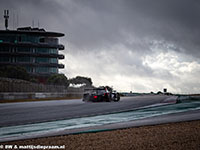 |
Why?
The sun was out in full force at Jérez, but a week later at Portimão the downpour was at times horrendous. It was not the season’s end that Masters Historic Racing, the Historic Grand Prix Car Association and the Formula Junior Association wished for but they plugged on and most drivers relished the challenge of the sweeping nature of the Autódromo do Algarve in the wet.
It was awful timing after weeks or in fact months of drought in the entire south of the Iberian peninsula that this would be compensated by endless rain in the three days of the festival, with the sun returning the day after, but that was the outlook at the start of the week. In the end, it wasn’t as bad as predicted, with sun still appearing on Friday after an initial wet start, followed by numerous dry spells on Sunday. Saturday, however, was rain-hit like there was no tomorrow. As those who remember Senna’s debut win in the 1985 Portuguese Grand Prix know very well, if the weather is bad in Portugal it’s really bad.
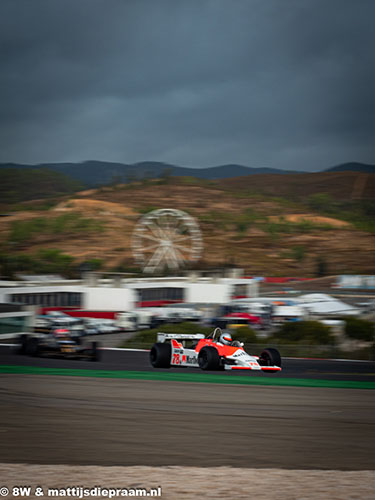
Marco Werner trailing Warren Briggs in MHFO practice. (photo 8W)
The final two races of the Masters Historic Formula One season were cornered by the German Britec Motorsport team whose two JPS Lotus cars from the Chrome Cars collection took a win each. On Saturday, Nick Padmore surged to the front in the post-82 Lotus 92 brought as a spare after his intended mount – the Lotus 77 he raced at Jérez – ran into trouble on the Thursday test day. The former MHFO champion used qualifying to get to know the 92, so lined up only fifth but in the race he proved unstoppable. Werner having used his set of wet tyres too hard on his Lotus 81 in wet Friday morning practice, was unable to hold Padmore on a three-year-old set drummed up from somewhere and later in the race proved defenseless against Jamie Constable’s Tyrrell 011 too.
Werner made up for it on the next day, hitting the front after two laps and never looking back. Meanwhile, early leader Steve Brooks’ Lotus 91 was torpedoed by Constable’s Tyrrell when the latter outbraked himself into the hairpin, was forced to take evasive action only to find that the kerbs acted as a launching platform for the out-of-control Tyrrell, the 011 turfing the Lotus off the track as it turned into the corner. Brooks was lucky that he was hit on the nose instead of mid-ship and was seen hurrying over towards Constable who was stuck in his cockpit, the impact having lodged his seatbelts tight. Both were OK, though, and shook hands on the incident. Towards the end of the race, an on-form Christophe d’Ansembourg (Williams FW07C) caught and passed Padmore for second, while the Belgian’s Mike Cantillon proved to a bit off the boil at Portimão – which was no real worry to him, as the Irishman did seal the post-78 title.
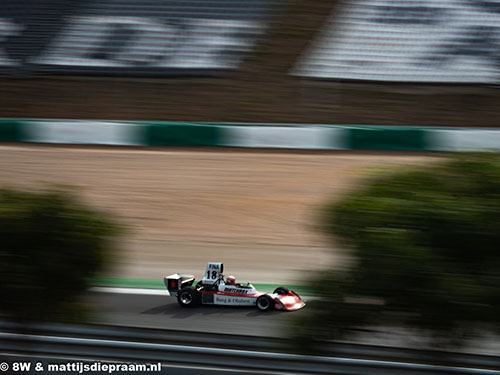
Marc Devis at speed in his Matchbox/Fina-liveried Surtees TS16. (photo 8W)
Meanwhile, in the pre-78 class, Lukas Halusa – a dominant champion already – gave his McLaren M23 for brother Niklas to explore, and the other Halusa did well to come home with third and second in class. Max Smith-Hilliard improved on his still hesitant Jérez form by lifting the Shadow DN5 to fourth overall and a strong class win on Saturday but was absent on Sunday due to a rushed return home for business. This allowed Marc Devis to be Sunday’s pre-78 star, the Belgian hauling his TS16 up to sixth overall, overtaking Halusa twice, having overcome a mid-race spin.
The pre-66 GP-car races hosted by the Historic Grand Prix Car Association turned into two very curious affairs, as the older front-engined cars proved to be much better suited to the wet Algarve circuit than their nimble mid-engined 1.5-litre counterparts. On Saturday, Michael Gans was the only one to break the trend, rushing his dominant Cooper T79 to win, but he was followed home by Richard Wilson’s Ferrari 246 Dino, the even more miraculous Lukas Halusa in his 1927 Bugatti T35B, and Guillermo Fierro and John Spiers in a pair of Maserati 250Fs.

Working on Michael Gans' Cooper-Climax T79. (photo 8W)
The next day, when Gans dropped back to 17th and towards the end dropped out entirely, front-engined cars claimed the first positions in the race, Spiers prevailing in a tense fight with Wilson, with Halusa performing more miracles by clinching another third in his Bug, and Fierro taking fourth. On both occasions, bar Gans’ T79 on Saturday, Rod Jolley’s Cooper T43 was best of the mid-engined gang. Jolley led home Mark Shaw’s Lotus 21 in race 1, but James Willis’ Cooper T45 moved ahead of the Lotus in race 2.
Alex Ames did more winning in Formula Junior, his Brabham BT6 claiming victories in both races, leaving the Lotus 22s of Lukas Halusa and Clive Richards to fight over second place on both occasions. The latter came through twice.
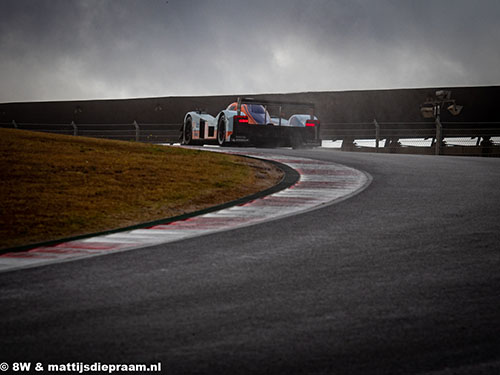
D'Ansembourg took away two MEL podiums with his Lola-Aston Martin DBR1-2. (photo 8W)
Werner and Padmore bagged more silverware in the two Masters Endurance Legends race. At Jérez, Christophe d’Ansembourg’s Lola-Aston Martin DBR1-2 had still profited from the pair’s elite-driver pitstop penalty but this time Werner did enough on both occasions to hand Padmore a Lola-Lotus B12/80 that was still in the lead as soon as the Briton rejoined the race. Not d’Ansembourg, but another driver was the Anglo-German pairing’s main rival, Xavier Micheron producing two brilliant races in his Riley & Scott-Elan MkIIIC that he may possibly have won hadn’t it been for two spins. On Saturday, the Frenchman recovered to take second, but the next day his Elan engine stalled and that was it. D’Ansembourg was happy to take second place, with Keith Frieser’s Zytek 09S moving up a place too. Richard Meins (Aston Martin DBR9) and Jason Wright (Ferrari 458 GT3) split the GT spoils between them.
In Masters Historic Sports Cars, Steve Brooks looked poised to underline his championship by taking an emphatic solo win on board of his Lola T70 Mk3B but when five minutes before the end the Lola came crawling into the pits, an intriguing fight for second suddenly transformed into a battle for the win. Local hero Pedro Macedo Silva was some ten seconds up the road from Andy Willis driving solo in Stephan Joebstl’s Lola T212, but the Portuguese driver was looking at accumulated time penalties amounting to 15 seconds that would be added to his race time once he had crossed the finish line. Up until the final lap, Willis was in the virtual lead but with one final push in his Lola T70 Mk3, Macedo Silva nailed the win by 1.3 seconds.
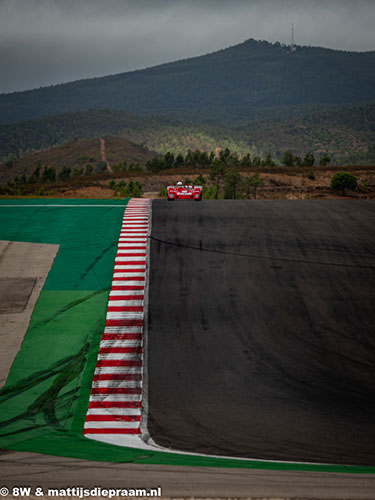
Gans' Lola T290 topping the crest in his Lola T290. (photo 8W)
An extremely wet and increasingly dark Masters Gentlemen Drivers race ended prematurely when on Saturday night dusk prevented running longer than 78 of the race’s allocated 90 minutes. It didn’t matter for the win, however, as Jon Minshaw was still miles ahead of the similar E-type of Lee Mowle and Phil Keen, with Keen flying in the wet but not catching his usual teammate Minshaw at a rate that would have won him the race after 90 minutes. Mark Holme and Jeremy Welch drove superbly to claim a stunning third overall in their Austin Healey 3000, their C2-class machine leading home the delayed CLP class winner of Andrew Haddon and Andy Wolfe. Their Elan ran without headlights during Haddon’s stint, and the Wolfe Manufacturing team was obliged to change the light fuse before Wolfe was allowed to rejoin. After one hour, the Geoff & Alan Letts Cortina was flagged off as the Masters Pre-66 Touring Car winner.
The two-hour GT & Sports Car Cup that was supposed to be Sunday’s headline proved to be somewhat of a fluke, the race declared a result after 46 minutes of racing. In a freak coincidence, two Shelby Mustang GT350s began dropping oil almost simultaneously, the Pierre-Alain Thibault example because of a stray Cobra sidescreen hitting its oil cooler while the Jeremy Cooke car burst an oilpipe. Both drivers stopped at a marshal’s post at their first opportunity, so the two trails didn’t look like presenting a lot of trouble. And yet they did. As the field was forced to follow the safety car around for some 20 minutes, the circuit vainly attempted to get rid of the slippery spots with a detergent of which two emptied two full truckloads without it having the desired effect. As the issue worsened, it was decided to park the cars on the main straight, but when the clock ticked away just too much for the rest of the programme to have a chance of being completed, the red flag came out for good and cars returned to their garages by entering the pitlane from its exit. Jason Minshaw and Phil Keen had led the race the lap before the safety car was called, so were declared the winners, followed by Haddon and Wolfe in the Elan, and local duo Diogo Ferrão and Pedro Macedo Silva in another Elan.
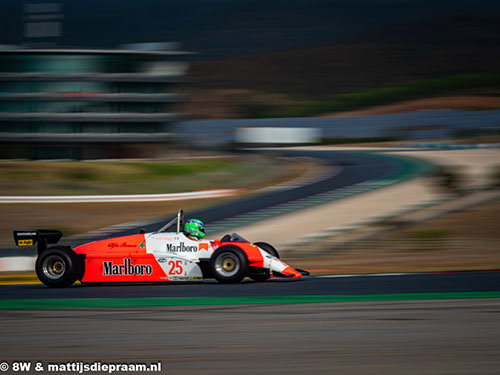
With his V12-engined Alfa Romeo 182, Richard Hope brought
much-welcomed engine variety to the F1 grid. (photo 8W)
No less than five local grids added to the programme. In the two historic races, the races for large-capacity cars were won by Francisco Mora and João Macedo Silva in their Porsche 911 RSRs, while Paolo Mendes’ Toyota Starlet doubled up in the under-1300cc races, before the MotoGP circus arrived as early as Sunday morning to take over the paddock still very much in use by its historic occupants...
